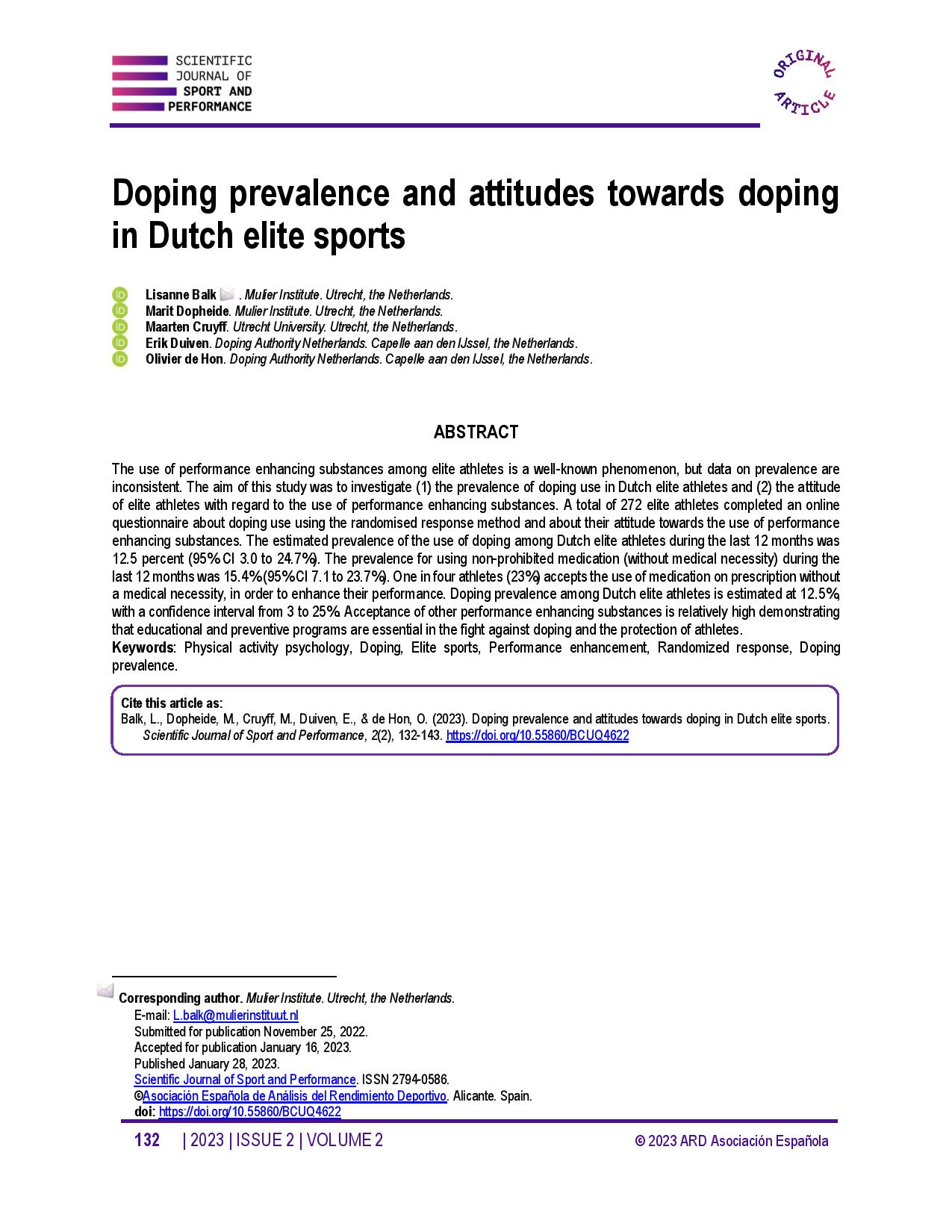Doping prevalence and attitudes towards doping in Dutch elite sports
Main Article Content
Abstract
The use of performance enhancing substances among elite athletes is a well-known phenomenon, but data on prevalence are inconsistent. The aim of this study was to investigate (1) the prevalence of doping use in Dutch elite athletes and (2) the attitude of elite athletes with regard to the use of performance enhancing substances. A total of 272 elite athletes completed an online questionnaire about doping use using the randomised response method and about their attitude towards the use of performance enhancing substances. The estimated prevalence of the use of doping among Dutch elite athletes during the last 12 months was 12.5 percent (95% CI 3.0 to 24.7%). The prevalence for using non-prohibited medication (without medical necessity) during the last 12 months was 15.4% (95% CI 7.1 to 23.7%). One in four athletes (23%) accepts the use of medication on prescription without a medical necessity, in order to enhance their performance. Doping prevalence among Dutch elite athletes is estimated at 12.5%, with a confidence interval from 3 to 25%. Acceptance of other performance enhancing substances is relatively high demonstrating that educational and preventive programs are essential in the fight against doping and the protection of athletes.
Article Details

This work is licensed under a Creative Commons Attribution-NonCommercial-ShareAlike 4.0 International License.
References
Albano, G. D., Amico, F., Cocimano, G., Liberto, A., Maglietta, F., Esposito, M., Rosi, G. L., Di Nunno, N., Salerno, M., & Montana, A. (2021). Adverse Effects of Anabolic-Androgenic Steroids: A Literature Review. Healthcare, 9(1), 97. https://doi.org/10.3390/healthcare9010097 DOI: https://doi.org/10.3390/healthcare9010097
Anderson, L. J., Tamayose, J. M., & Garcia, J. M. (2018). Use of growth hormone, IGF-I, and insulin for anabolic purpose: Pharmacological basis, methods of detection, and adverse effects. Mol Cell Endocrinol, 464, 65-74. https://doi.org/10.1016/j.mce.2017.06.010 DOI: https://doi.org/10.1016/j.mce.2017.06.010
Backhouse, S. H., Whitaker, L., & Petróczi, A. (2013). Gateway to doping? Supplement use in the context of preferred competitive situations, doping attitude, beliefs, and norms. Scand J Med Sci Spor, 23(2), 244-252. https://doi.org/10.1111/j.1600-0838.2011.01374.x DOI: https://doi.org/10.1111/j.1600-0838.2011.01374.x
Baoutina, A., Bhat, S., Li, D. K., & Emslie, K. R. (2022). Towards a robust test to detect gene doping for anabolic enhancement in human athletes. Drug Test Anal. https://doi.org/10.1002/dta.3411 DOI: https://doi.org/10.1002/dta.3411
Boardley, I. D., Smith, A. L., Ntoumanis, N., Gucciardi, D. F., & Harris, T. S. (2019). Perceptions of coach doping confrontation efficacy and athlete susceptibility to intentional and inadvertent doping. Scand J Med Sci Spor, 29(10), 1647-1654. https://doi.org/10.1111/sms.13489 DOI: https://doi.org/10.1111/sms.13489
Cantelmo, R. A., da Silva, A. P., Mendes-Junior, C. T., & Dorta, D. J. (2020). Gene doping: Present and future. Eur J Sport Sci, 20(8), 1093-1101. https://doi.org/10.1080/17461391.2019.1695952 DOI: https://doi.org/10.1080/17461391.2019.1695952
Dopheide, M., Elling, A., & Balk, L. (2020). Antidopingbeleid in de Nederlandse topsport. Ervaringen en percepties van (oud-)topsporters. Accessed 18-2-2022. https://www.mulierinstituut.nl/publicaties/25383/antidopingbeleid-in-de-nederlandse-topsport/
Duiven, E., & de Hon, O. (2015). De Nederlandse topsporter en het anti-dopingbeleid 2014 - 2015. Accessed 18-2-2022 https://www.dopingautoriteit.nl/media/files/2015/Topsportonderzoek_doping_2015-07-21_DEF.pdf
Elbe, A.-M., & Pitsch, W. (2018). Doping prevalence among Danish elite athletes. Perform Enhanc Heal, 6(1), 28-32. https://doi.org/10.1016/j.peh.2018.01.001 DOI: https://doi.org/10.1016/j.peh.2018.01.001
Gild, M. L., Stuart, M., Clifton-Bligh, R. J., Kinahan, A., & Handelsman, D. J. (2022). Thyroid Hormone Abuse in Elite Sports: The Regulatory Challenge. J Clin Endocrinol Metab, 107(9), e3562-e3573. https://doi.org/10.1210/clinem/dgac223 DOI: https://doi.org/10.1210/clinem/dgac223
Gleaves, J., Petróczi, A., Folkerts, D., de Hon, O., Macedo, E., Saugy, M., & Cruyff, M. (2021). Doping Prevalence in Competitive Sport: Evidence Synthesis with "Best Practice" Recommendations and Reporting Guidelines from the WADA Working Group on Doping Prevalence. Sports Med, 51(9), 1909-1934. https://doi.org/10.1007/s40279-021-01477-y DOI: https://doi.org/10.1007/s40279-021-01477-y
Haisma, H. J., & de Hon, O. (2006). Gene Doping. Int J Sports Med, 27(4), 257-266. https://doi.org/10.1055/s-2006-923986 DOI: https://doi.org/10.1055/s-2006-923986
Hon, O. de, Kuipers, H., & van Bottenburg, M. van. (2015). Prevalence of doping use in elite sports: a review of numbers and methods. Sports Med, 45, 57-69. https://doi.org/10.1007/s40279-014-0247-x DOI: https://doi.org/10.1007/s40279-014-0247-x
Kegelaers, J., Wylleman, P., De Brandt, K., Van Rossem, N., & Rosier, N. (2018). Incentives and deterrents for drug-taking behaviour in elite sports: a holistic and developmental approach. Eur Sport Manag Q, 18(1), 112-132. https://doi.org/10.1080/16184742.2017.1384505 DOI: https://doi.org/10.1080/16184742.2017.1384505
Kuk, A. Y. C. (1990). Asking sensitive questions indirectly. Biometrika, 77(2), 436-438. https://doi.org/10.1093/biomet/77.2.436 DOI: https://doi.org/10.1093/biomet/77.2.436
Lensvelt-Mulders, G. J. L. M., Hox, J. J., van der Heijden, P. G. M., & Maas, C. J. M. (2005). Meta-Analysis of Randomized Response Research. Sociol Method Res, 33(3), 319-348. https://doi.org/10.1177/0049124104268664 DOI: https://doi.org/10.1177/0049124104268664
Petróczi, A., Cruyff, M., de Hon, O., Sagoe, D., & Saugy, M. (2022). Hidden figures: Revisiting doping prevalence estimates previously reported for two major international sport events in the context of further empirical evidence and the extant literature. Front Sports Act Living, 4. https://doi.org/10.3389/fspor.2022.1017329 DOI: https://doi.org/10.3389/fspor.2022.1017329
Pielke, R. (2018). Assessing Doping Prevalence is Possible. So What Are We Waiting For? Sports Med, 48(1), 207-209. https://doi.org/10.1007/s40279-017-0792-1 DOI: https://doi.org/10.1007/s40279-017-0792-1
Pitsch, W., Emrich, E., & Klein, M. (2007). Doping in elite sports in Germany: results of a www survey. Eur J Sport Soc, 4(2), 89-102. https://doi.org/10.1080/16138171.2007.11687797 DOI: https://doi.org/10.1080/16138171.2007.11687797
Salamin, O., Kuuranne, T., Saugy, M., & Leuenberger, N. (2018). Erythropoietin as a performance-enhancing drug: Its mechanistic basis, detection, and potential adverse effects. Mol Cell Endocrinol, 464, 75-87. https://doi.org/10.1016/j.mce.2017.01.033 DOI: https://doi.org/10.1016/j.mce.2017.01.033
Siebert, D. M., & Rao, A. L. (2018). The Use and Abuse of Human Growth Hormone in Sports. Sport Heal A Multidiscip Approach, 10(5), 419-426. https://doi.org/10.1177/1941738118782688 DOI: https://doi.org/10.1177/1941738118782688
Smit, D. L., Bond, P., & De Ronde, W. (2022). Health effects of androgen abuse: a review of the HAARLEM study. Curr Opin Endocrinol Diabetes Obes, 29(6), 560-565. https://doi.org/10.1097/MED.0000000000000759 DOI: https://doi.org/10.1097/MED.0000000000000759
Ulrich, R., Pope, H. G., Cléret, L., Petróczi, A., Nepusz, T., Schaffer, J., Kanayama, G., Comstock, R. D., & Simon, P. (2018). Doping in Two Elite Athletics Competitions Assessed by Randomized-Response Surveys. Sports Med, 48(1), 211-219. https://doi.org/10.1007/s40279-017-0765-4 DOI: https://doi.org/10.1007/s40279-017-0765-4
van den Hout, A., & van der Heijden, P. G. M. (2004). The Analysis of Multivariate Misclassified Data With Special Attention to Randomized Response Data. Sociol Methods Res, 32(3), 384-410. https://doi.org/10.1177/0049124103257440 DOI: https://doi.org/10.1177/0049124103257440




